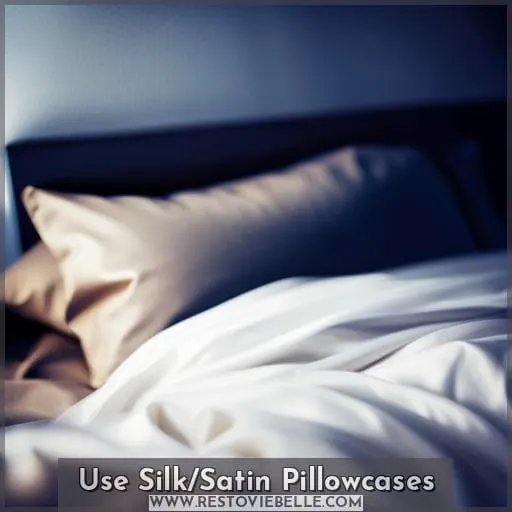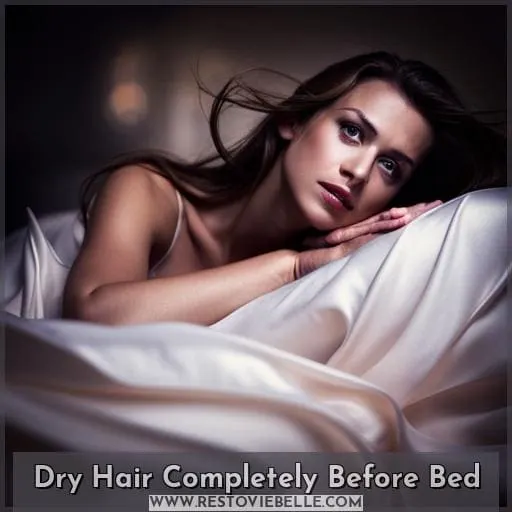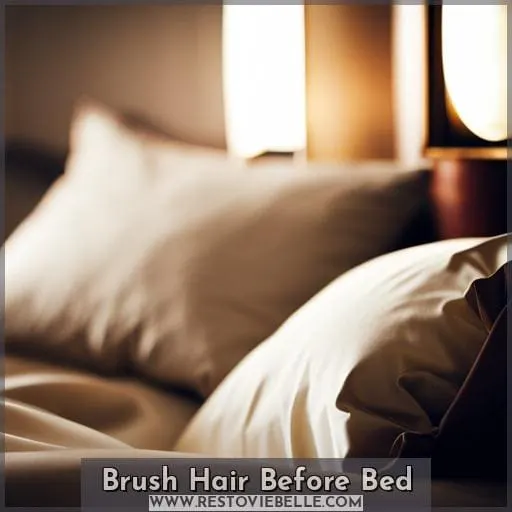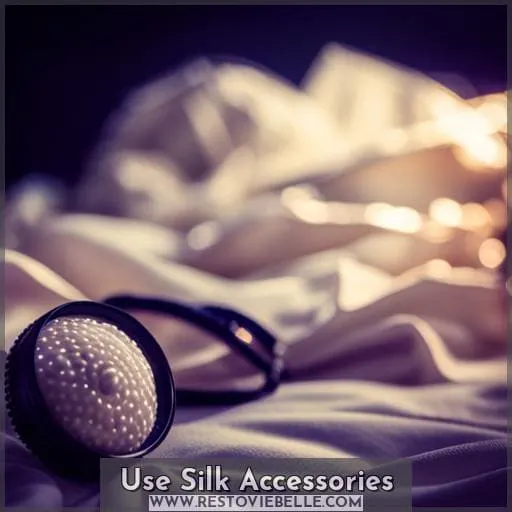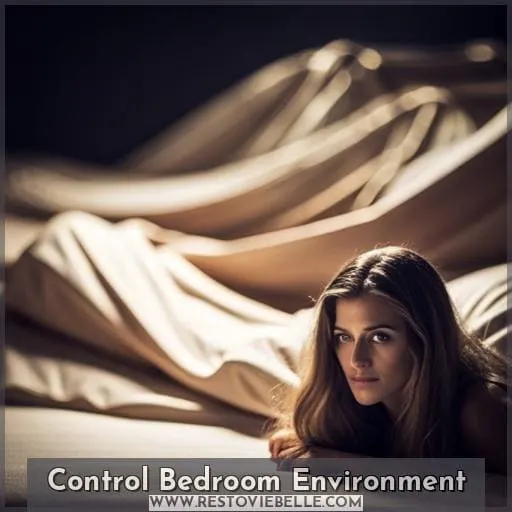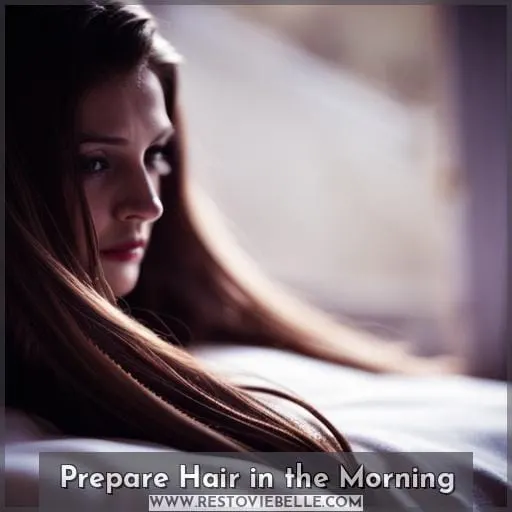This site is supported by our readers. We may earn a commission, at no cost to you, if you purchase through links.
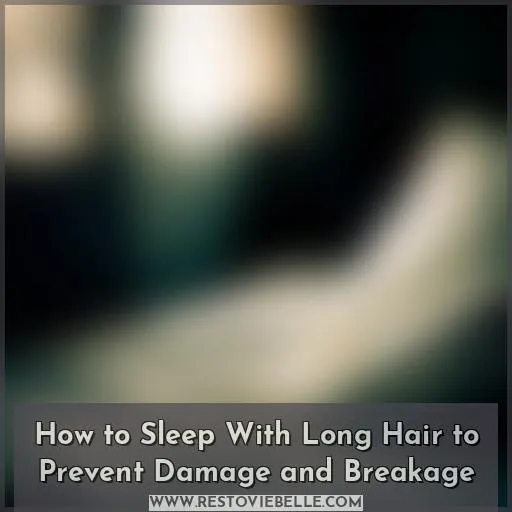 Up to 100 strands of hair falling out per day is normal,
Up to 100 strands of hair falling out per day is normal,
but sleeping improperly with long hair can cause excessive breakage.
To keep your locks lush, use a silk pillowcase.
The smooth fabric minimizes friction, protecting strands.
Also, tie hair up loosely and sleep on your back.
This avoids tangling and damage from tossing and turning.
Remember to be gentle brushing hair before bed to distribute oils.
With some simple steps, you can wake up with hair that’s damage-free.
Table Of Contents
Use Silk/Satin Pillowcases
By opting for silk or satin pillowcases, you’re minimizing friction and moisture loss overnight. The smooth fabrics glide easily over hair strands without tugging or pulling, reducing friction-induced breakage.
Silk’s protein composition is similarly structured to hair cuticles, retaining moisture instead of wicking it away.
A silk case also lets you comfortably change sleep positions without hair disturbance. Come morning, your hair will thank you for the gentle treatment. With this simple swap, you can wake up with shiny, smoothed strands minus the tangles and bedhead.
Say goodbye to morning frizz and flyaways too. By choosing the right pillowcase fabric, you can maintain your hair’s health and integrity all night long.
Dry Hair Completely Before Bed
Dry your hair thoroughly before bedtime to prevent weakening the hair cuticle. Ensuring that your hair is completely dry before hitting the hay is an essential step in pre-sleep hair care.
Here are four reasons why drying your hair completely before bed should be a part of your healthy nighttime routine:
- Haircuticle protection: By drying your tresses, you create a barrier that shields the delicate cuticles from friction and potential damage.
- Nocturnal moisture preservation: Dry strands are less prone to absorbing excess moisture during sleep, preventing them from becoming weak and susceptible to breakage.
- Healthy nighttime routines: Incorporating this simple step into your evening routine can help maintain strong, resilient locks for long-term health.
- Overnight hair maintenance: Sleeping with damp or wet hair can lead to tangling and frizz, making it harder to manage in the morning.
So make sure you take a few extra minutes each night to dry those lovely locks fully—your long mane will thank you!
Brush Hair Before Bed
Comb through your hair thoroughly before bedtime to minimize knots and tangles that can lead to breakage. Use a wide-toothed comb or wet brush to gently detangle your strands from roots to ends.
Brushing before bed helps distribute your hair’s natural oils down the hair shaft while removing dirt and debris. It also lets you style your hair into a protective low-maintenance hairstyle for sleeping, like a loose braid or twist.
Prepping your hair this way makes it easier to comb in the morning too. Getting in the habit of a pre-sleep brushing routine helps maintain the strength and integrity of your long locks overnight.
So be sure to carve out a few minutes before bed to gently brush for happy, healthy hair.
Use Protective Nighttime Hairstyles
When it’s time for bed, put your long hair up. Try a loose top knot, braid, or twist to keep your hair secure and minimize friction.
Using a soft scrunchie and avoiding tight styles will prevent breakage overnight.
Loose Braids
You’re braiding your hair loosely before bed to protect it during sleep. Loose braids reduce friction and tangling, giving your long hair a break overnight.
Apply a nourishing hair oil or serum from midshaft to ends, sealing in moisture as you braid.
Position braids comfortably at the nape of your neck or crown of your head. Experiment with one long braid, two braids, or multiple smaller braids.
Wake up to beautiful, voluminous waves or curls after gently undoing your Bedtime Beauty braids.
Silk Headscarves
Continuing on from braiding your hair before bed, you can also wrap your hair in a silk headscarf or turban to gently secure your locks while you sleep. This’ll prevent breakage by keeping your hair protected and minimizing friction against your pillow.
Silk scarves are more delicate than satin, so opt for a satin-lined scarf for durability. Twisting your hair into a loose bun before wrapping allows for volume. Ensure ties are loose to avoid damage.
Headscarves maintain your style and prevent tangles in all hair types. Applying a hydrating serum under the fabric boosts moisture.
Avoid Tight Ponytails/Buns
When you’re preparing your hair for bed, you’ll want to avoid tight ponytails or buns. Tight hairstyles can put a lot of stress on your hair and scalp, potentially causing breakage and hair loss along the hairline if done repeatedly.
Instead, opt for loose and comfortable updos. Try braiding your hair into one loose braid or two braids at the nape of your neck.
Another protective style is a loose top knot secured at the crown of your head with a soft fabric scrunchie or hair tie.
The key is keeping your hair up and out of the way, while not creating too much tension or friction on the strands.
Apply Overnight Treatments
Consider using overnight hair masks or leave-in conditioners before bedtime. These moisturizing treatments can deeply nourish hair and scalp while you sleep.
Opt for lightweight formulas to avoid damp or wet hair before bed.
Hair Masks
You should apply a nourishing hair mask before bed to deeply hydrate, treat damage, and prevent breakage overnight.
Using a DIY hair mask with natural oils and butters like avocado, coconut, and shea can deeply nourish and hydrate hair overnight.
Look for hair masks with keratin, ceramides, or amino acids to strengthen and repair damage.
Focus the hair mask on your ends since this is the oldest, most fragile part of your hair.
Secure your hair with a gentle wrap or silk scarf after applying the mask to allow deep penetration.
Rinse thoroughly in the morning and style as usual for soft, strong tresses.
Leave-in Conditioners
You’ll want to apply a lightweight leave-in conditioner or hair mask before bedtime for added moisture and to nourish your hair as you sleep.
Benefits:
- Hydration
- Frizz reduction
- Damage repair
- Softness
- Manageability
Application Tips:
- Apply to damp hair
- Focus on ends
- Use sparingly
- Layer under styler
- Distribute evenly
Best Brands:
- It’s A 10
- Olaplex No. 6
- Briogeo Farewell Frizz
- Verbena Shea Butter
- Kinky Curly Knot Today
Leave-in conditioners provide needed moisture and nutrients while you rest to keep your long hair strong, soft, and protected from breakage. Experiment to find the right lightweight leave-in that works best for your hair type and needs.
Use Silk Accessories
To protect your long hair while you sleep, it’s important to consider using silk accessories. Silk has numerous benefits when it comes to hair protection and bedtime hair care.
- Reduced Friction: Silk pillowcases, scrunchies, and headbands create less friction against your strands compared to other materials like cotton or polyester.
- Retained Moisture: Unlike other fabrics that absorb moisture from your hair, silk retains natural oils and hydration overnight.
- Gentle on Hair Cuticles: The smooth texture of silk prevents rough handling of the cuticle layer in each strand of hair. By reducing friction between individual hairs, there’s less damage caused during movement throughout the night.
When selecting silk accessories for bedtime use, choose high-quality options made from pure mulberry or charmeuse satin material for maximum benefits. Silk vs Satin: Some people also prefer satin as an alternative because it offers similar advantages but at a lower cost.
Choose what works best for you based on personal preference, routine, and budget.
By incorporating these silky additions into your sleep routine, you can keep your long locks protected, nourished, and healthy all through the night!
Control Bedroom Environment
When it comes to caring for your long locks overnight, considering your sleep environment is key. From humidity to airflow, aspects of your bedroom can either help or hinder your hair health goals.
Let’s explore some strategies to create an optimal overnight environment for your luscious lengths.
First, monitor the humidity in your bedroom. Low humidity can lead to dry, brittle hair. Use a humidifier to add moisture back into the air. Aim to keep bedroom humidity around 40-50%. Also be sure your hair is well-hydrated before bedtime with leave-in conditioners or hair masks.
Next, look at your pillowcases. Cotton pillowcases are gentler on hair than slippery satin.
Finally, consider how you position your hair at night. Pulling your hair up into a loose scrunchie or pineapple ponytail takes tension off your strands. Letting your hair fall freely across the pillow can lead to knotting and damage.
With some simple tweaks to your sleep space, you can wake up with healthy, hydrated locks.
Humidifier
Using a humidifier in your bedroom to add moisture back into the air can help prevent your long hair from drying out overnight. It creates an environment that promotes healthy hair growth and reduces breakage.
Picture this: on one side of the room, you have a sleek humidifier silently releasing fine mist particles into the air, while on the other side sits your cozy bed with its soft satin sheets and plush pillows.
The combination of these elements creates an oasis for your locks, protecting them from dryness and frizz while you sleep peacefully through the night.
Fan
Leveraging the previous tip on humidifiers, you’d also do well to use a fan in your bedroom to keep the air current moving and prevent sweating.
Strategically place the fan to optimize air circulation without creating a disruptive draft.
Adjust the fan speed and oscillating motion for ideal temperature regulation.
White noise from lower fan speeds can promote sleep, while faster speeds may dry hair excessively.
Monitor humidity, breakage, and overall hair health as you determine optimal settings.
Incorporating Ayurvedic oils with protective hairstyles like loose braids can further nurture your strands overnight.
Prepare Hair in the Morning
Frequently mist your hair with a hydrating spray in the morning to refresh your curls and scalp without having to wash it. This simple step can help you start the day with revitalized hair that looks and feels great.
If you’re short on time, dry shampooing is another option for quick refreshment.
Consider using moisturizing masks or leave-in conditioners as part of your morning routine to provide extra hydration and nourishment for your long locks.
Take a few minutes each morning to give yourself a stimulating scalp massage, which can promote blood circulation and contribute to healthy hair growth.
When styling, be sure to choose hairstyling products that are suitable for your specific needs and concerns – whether it’s frizz control or heat protection – so you can achieve the desired look while also protecting your strands from damage throughout the day.
Consider Getting a Satin Bonnet
If you want to protect your long hair while you sleep, consider getting a satin bonnet. Satin bonnets reduce friction on your hair while you sleep, preventing breakage and frizz.
They’re a great alternative to silk pillowcases if you can’t replace your regular pillowcase.
Benefits of satin bonnets
You’ll maintain moisture and decrease friction by investing in a satin bonnet for nighttime hair protection.
Opt for a roomy bonnet with adjustable ties to avoid constricting your hair. Look for a soft, high quality satin that won’t tug.
Put your hair in a loose braid or pineapple under the bonnet. The smooth fabric retains moisture and allows you to wake up with sleek, undamaged tresses.
Alternatives to satin bonnets
If you’re not sold on satin bonnets, there are some other options you can try for protecting your hair at night:
- Wide headbands
- Fabric wraps
- Loose ponytails
- Hair masks
- Massage oils
Explore accessories like headbands, wraps, and oils for added protection without the satin bonnet.
A loose ponytail or hydrating hair mask can also help prevent breakage overnight.
Proper care for long hair
You’re gonna want to get a satin bonnet if you have long hair and want to prevent breakage while sleeping.
Proper care for long hair involves more than just protecting it at night. Consider trendy haircuts that reduce the weight of your locks, dietary supplements for nourishment from within, natural masks for hydration, heat styling tools in moderation, and scalp massages to promote healthy growth.
Conclusion
All in all, it’s easy to protect long hair from damage and breakage while sleeping.
By investing in a silk or satin pillowcase, brushing hair before bed, and using protective nighttime hairstyles, you’ll be sure to wake up with your locks looking just as lush as when you went to bed.
Don’t let your tresses take a hit – take the necessary steps to ensure your mane is in the best shape possible.

